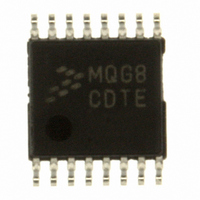MC9S08QG8CDTE Freescale Semiconductor, MC9S08QG8CDTE Datasheet - Page 253

MC9S08QG8CDTE
Manufacturer Part Number
MC9S08QG8CDTE
Description
IC MCU 8K FLASH 10MHZ 16-TSSOP
Manufacturer
Freescale Semiconductor
Series
HCS08r
Datasheet
1.MC9S08QG8CDTER.pdf
(314 pages)
Specifications of MC9S08QG8CDTE
Core Processor
HCS08
Core Size
8-Bit
Speed
20MHz
Connectivity
I²C, SCI, SPI
Peripherals
LVD, POR, PWM, WDT
Number Of I /o
12
Program Memory Size
8KB (8K x 8)
Program Memory Type
FLASH
Ram Size
512 x 8
Voltage - Supply (vcc/vdd)
1.8 V ~ 3.6 V
Data Converters
A/D 8x10b
Oscillator Type
Internal
Operating Temperature
-40°C ~ 85°C
Package / Case
16-TSSOP
Cpu Family
HCS08
Device Core Size
8b
Frequency (max)
20MHz
Interface Type
I2C/SCI/SPI
Total Internal Ram Size
512Byte
# I/os (max)
12
Number Of Timers - General Purpose
1
Operating Supply Voltage (typ)
2.5/3.3V
Operating Supply Voltage (max)
3.6V
Operating Supply Voltage (min)
1.8V
On-chip Adc
8-chx10-bit
Instruction Set Architecture
CISC
Operating Temp Range
-40C to 85C
Operating Temperature Classification
Industrial
Mounting
Surface Mount
Pin Count
16
Package Type
TSSOP
Processor Series
S08QG
Core
HCS08
Data Bus Width
8 bit
Data Ram Size
512 B
Maximum Clock Frequency
20 MHz
Number Of Programmable I/os
12
Number Of Timers
1
Operating Supply Voltage
1.8 V to 3.6 V
Maximum Operating Temperature
+ 85 C
Mounting Style
SMD/SMT
3rd Party Development Tools
EWS08
Development Tools By Supplier
DEMO9S08QG8E
Minimum Operating Temperature
- 40 C
Package
16TSSOP
Family Name
HCS08
Maximum Speed
20 MHz
For Use With
DEMO9S08QG8E - BOARD DEMO FOR MC9S08QG8
Lead Free Status / RoHS Status
Lead free / RoHS Compliant
Eeprom Size
-
Lead Free Status / Rohs Status
Compliant
Available stocks
Company
Part Number
Manufacturer
Quantity
Price
Company:
Part Number:
MC9S08QG8CDTE
Manufacturer:
ABB
Quantity:
101
Company:
Part Number:
MC9S08QG8CDTE
Manufacturer:
Freescale Semiconductor
Quantity:
41 991
Part Number:
MC9S08QG8CDTE
Manufacturer:
FREESCALE
Quantity:
20 000
The SYNC command is unlike other BDC commands because the host does not necessarily know the
correct communications speed to use for BDC communications until after it has analyzed the response to
the SYNC command.
To issue a SYNC command, the host:
The target, upon detecting the SYNC request from the host (which is a much longer low time than would
ever occur during normal BDC communications):
The host measures the low time of this 128-cycle sync response pulse and determines the correct speed for
subsequent BDC communications. Typically, the host can determine the correct communication speed
within a few percent of the actual target speed and the communication protocol can easily tolerate speed
errors of several percent.
17.2.4
The BDC includes one relatively simple hardware breakpoint that compares the CPU address bus to a
16-bit match value in the BDCBKPT register. This breakpoint can generate a forced breakpoint or a tagged
breakpoint. A forced breakpoint causes the CPU to enter active background mode at the first instruction
boundary following any access to the breakpoint address. The tagged breakpoint causes the instruction
opcode at the breakpoint address to be tagged so that the CPU will enter active background mode rather
than executing that instruction if and when it reaches the end of the instruction queue. This implies that
tagged breakpoints can only be placed at the address of an instruction opcode while forced breakpoints can
be set at any address.
The breakpoint enable (BKPTEN) control bit in the BDC status and control register (BDCSCR) is used to
enable the breakpoint logic (BKPTEN = 1). When BKPTEN = 0, its default value after reset, the
breakpoint logic is disabled and no BDC breakpoints are requested regardless of the values in other BDC
breakpoint registers and control bits. The force/tag select (FTS) control bit in BDCSCR is used to select
forced (FTS = 1) or tagged (FTS = 0) type breakpoints.
The on-chip debug module (DBG) includes circuitry for two additional hardware breakpoints that are more
flexible than the simple breakpoint in the BDC module.
Freescale Semiconductor
•
•
•
•
•
•
•
•
•
Drives the BKGD pin low for at least 128 cycles of the slowest possible BDC clock (The slowest
clock is normally the reference oscillator/64 or the self-clocked rate/64.)
Drives BKGD high for a brief speedup pulse to get a fast rise time (This speedup pulse is typically
one cycle of the fastest clock in the system.)
Removes all drive to the BKGD pin so it reverts to high impedance
Monitors the BKGD pin for the sync response pulse
Waits for BKGD to return to a logic high
Delays 16 cycles to allow the host to stop driving the high speedup pulse
Drives BKGD low for 128 BDC clock cycles
Drives a 1-cycle high speedup pulse to force a fast rise time on BKGD
Removes all drive to the BKGD pin so it reverts to high impedance
BDC Hardware Breakpoint
MC9S08QG8 and MC9S08QG4 Data Sheet, Rev. 5
Development Support
251











